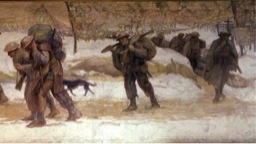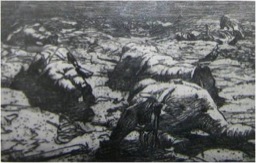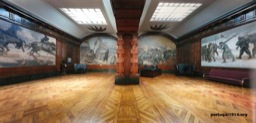História | Painter of the Great War. Sousa Lopes and the Military Museum of Lisbon. |
Autor | Carlos Silveira |
Person 1 First name | Adriano de |
Person 1 Surname | SOUSA LOPES |
Ocupation Person 1 | Pintor de guerra |
Story / Relato | Adriano de Sousa Lopes (1879-1944) is one of the most interesting artists who covered the First World War in France. Serving as captain of the Portuguese Expeditionary Corps in 1917-1918, he developed his work in different media: monumental paintings for a military museum, a collection of lively etchings and numerous drawings executed at the trenches. They cover a wide range of subjects, from the fearful combat at the trenches to everyday life of Portuguese troops at the British front in Flanders. He was trained as an historical painter at the Lisbon Academy of Fine Arts and later at Paris École National des Beaux-Arts, studying since 1903 under Fernand Cormon. He also attended Académie Julian and was a regular exhibitor at the Paris Salon. Living in France until the late 1920’s, he absorbed styles such as fin-de-siècle Symbolism and mainly Impressionist’s color techniques, tempered with a Naturalist vision, evident in cityscapes of Venice and later at the Côte d’Azur. Witnessing French war mobilization since 1914 and inspired by the work of François Flameng and Lucien Jonas, three years later he proposed a plan to the Portuguese government to be an official war artist. Before embarking to France he announced his work of propaganda for the country’s military effort but, as happened with many European artists, war changed his plans. Faced with the reality of trench warfare and the misery of soldier’ daily life in Flanders, his initial mission became over time a more personal view of war, meant to immortalize the action and human drama he witnessed every day. The monumental painting A Rendição (The Replacement) and a collection of engravings are among the masterpieces of his career. The first depicts an exhausted platoon coming from the first line, rendering a collective portrait of the traumatic experience at the trenches. Its human size figures are disposed like a classical frieze, as Sargent did in his iconic war painting, Gassed (Imperial War Museum, London). Later Sousa Lopes executed many etchings, inspired by his field drawings: soldiers on foot at the trenches, waiting for an invisible enemy; a patrol crawling through No man’s land, suddenly detected by a massive very-light; Portuguese lines bombed at Lacouture on the morning of 9th April 1918, day of the fatal battle of La Lys; or symbolic evocations of war, like a grave of an unknown soldier left alone in the wet lowlands of Flanders Fields. Today Sousa Lopes’ best work can be seen at the Military Museum of Lisbon, whose WW1 rooms were specially built in 1936 – to house seven monumental oil paintings. These are large scenes of dangerous operations at the front, like the reloading of artillery amidst massive bombings of the enemy, episodes from the battle of La Lys or the unequal fight against German submarines. Finally, a poignant homage is paid in the painting The Mothers of the Unknown Soldier, buried for eternity at the dwelling place of kings, the gothic Batalha monastery. These works are rightly regarded as the best (even the only) battle images of Portuguese Art. |
Data em que a história começou | 1919 |
Data em que a história terminou | 1923 |
Local em que a história aconteceu | Western Front |
Objectos associados / Summary description of items | 1 painting, 1 Etching |
Select keywords | Portuguese Expeditionary Corps; War painting |
Theatres | Western Front |
Title | The Replacement |
Nome da pessoa a que o objecto está associado (Person 1) | Adriano de Sousa Lopes |
Contributor | Lisbon Military Museum |
Descrição do objecto | The Replacement (detail), circa 1919-1923 Oil on canvas, 296 x 1252 cm, Lisbon Military Museum |
Tipo de objecto | Pintura a óleo |
Language | Inglês |
Date created | 1917 |
Date range ending | 1919 |
Location (place name) | Western Front |
Select keywords | Portuguese Expeditionary Corps; War painting |
Theatres | Western Front |
Title | Patrol in No man’s land |
Nome da pessoa a que o objecto está associado (Person 1) | Adriano de Sousa Lopes |
Contributor | Lisbon Military Museum |
Descrição do objecto | Patrol in No man’s land, 1919 Etching |
Tipo de objecto | Etching |
Language | Inglês |
Date created | 1919 |
Date range ending | 1919 |
Location (place name) | Western Front |
Select keywords | Portuguese Expeditionary Corps; War painting |
Theatres | Western Front |
Title | Great War Room in the Military Museum of Lisbon |
Nome da pessoa a que o objecto está associado (Person 1) | Adriano de Sousa Lopes |
Contributor | Military Museum of Lisbon |
Descrição do objecto | Wall in the Military Museum of Lisbon |
Tipo de objecto | Painting |
Language | Inglês |
Date created | 1919 |
Date range ending | 1919 |
Location (place name) | Western Front |
Select keywords | Portuguese Expeditionary Corps; War painting |
Theatres | Western Front |
Title | Great War Room in the Military Museum of Lisbon |
Nome da pessoa a que o objecto está associado (Person 1) | Adriano de Sousa Lopes |
Contributor | Military Museum of Lisbon |
Descrição do objecto | Wall in the Military Museum of Lisbon |
Tipo de objecto | Painting |
Language | Inglês |
Date created | 1919 |
Date range ending | 1919 |
Location (place name) | Western Front |
Select keywords | Portuguese Expeditionary Corps; War painting |
Theatres | Western Front |



